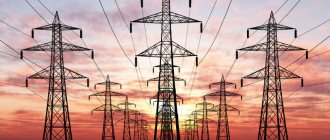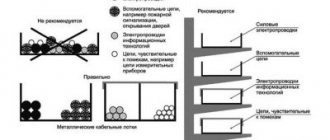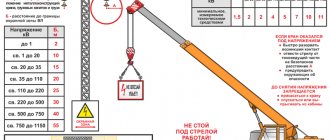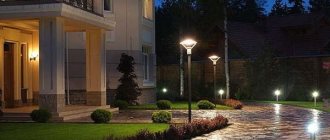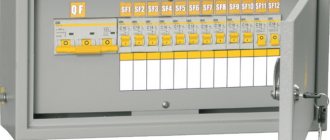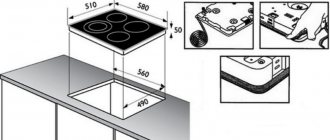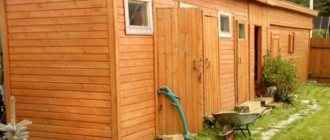Dangerous radiation from power lines was noticed at the end of the last century. SanPiN standards have been developed, which calculate the minimum safe distance from power lines to a residential building, depending on the size of the voltage in the network. Based on this distance, sanitary zones for power lines were created under high-voltage power lines and the concept of a “burden zone” was introduced - land dangerously close to radiation harmful to health. The sale of residential buildings and plots for individual housing construction and SNT in the sanitary zone of power lines is prohibited.
Near residential buildings
Distance from power lines and magnetic radiation
When electrons pass through wires, they create an electromagnetic field around their carrier. Depending on the type of current, the radiation value is constant or variable. A continuous change in the current value from plus to minus and vice versa causes the field to change its value 2 times more often.
In the evening
Exposure to magnetic radiation negatively affects a person’s physical condition, just like exposure to radiation.
Research on the effects of electromagnetic radiation on humans and wildlife began to be carried out at the end of the 70s. Based on the results of a survey of people in different countries, the WHO - World Health Organization determined the maximum permissible radiation levels in hertz per unit of time. In the Russian Federation and other countries, regulations have been developed prohibiting industrial and civil construction at close distances from power lines.
Secured territory
People who spent a long time in a strong field zone were diagnosed with cancer and heart disease. Women suffered from infertility. Men were plagued by pathologies of the genitourinary system. General weakness appeared. Life expectancy was reduced.
Cheap land near the protected zone
Based on SanPiN standards, construction rules were developed and sanitary zones were created under high-voltage lines. Children's institutions located in the danger zone must be closed. It is prohibited to build residential buildings for permanent and temporary residence closer than the distance indicated to high-voltage lines in SanPiN 2971-84.
It is impossible to sell a house located in a dangerous area. Sanitary and fire safety organizations will not approve such a document. When developing individual housing construction sites, it is necessary to take into account the distance to the power lines located nearby.
Electromagnetic wave propagation diagram
How dangerous the radiation from high-voltage lines is is demonstrated by land prices. The cost of plots near power lines is low. As you move away, it rises every 50 m. You shouldn’t be tempted by the cheapness. You need to think about the health of your family.
Distance from power lines to the fence of a residential private house
Every day a person uses electricity, which comes to our home through power lines.
The distance from the fence of a private house to the power line plays an important role. Because magnetic waves emitted by power lines negatively affect human health. But few people delve into the essence of this problem.
Therefore, he ignores the installation of more and more new poles near the residential area.
High voltage power lines
However, it is still recommended to adhere to the rules established by law. The health of all family members may depend on this. The reasons why you should adhere to the established rules are obvious:
- In the power transmission line security zone in the immediate vicinity of the power line itself, the area can be fenced off with an industrial fence. In this case, a complete ban is placed on the construction of residential buildings near the dangerous area.
- To protect human health, since electromagnetic fields negatively affect the state of the human brain.
That is why the safe distance from power lines to the fence of a residential building is clearly regulated by SNiP and SanPiN standards.
Health hazards from power lines
A voltage of 10 kV is considered safe for humans. It creates a background density not exceeding 10 μT - microtesla. For comparison, the Earth's magnetic field is 30–50 μT.
Standard support drawing
It differs from the radiation generated by overhead lines in that it has a constant or smoothly varying value. A current with a frequency of 50 Hz passes through the power line - this means that per second the current changes its direction 50 times, a complete oscillation occurs - an alternating current wave. The value of the emitted magnetic field also changes with this frequency.
The highest value of natural vibrations reaches 40 Hz. When constantly in the zone of magnetic waves with high values, malfunctions occur in the human body. This is possible not only when standing under power lines for a long time, but also next to household electrical appliances, especially thermal ones. The damage from the close proximity of overhead lines is commensurate with the harm to health caused by an iron, refrigerator, washing machine, or computer.
Types of supports
In the European Union, it is generally accepted that if the voltage in the power line wires is higher than 35 kV and the apartment is located closer than the standard interval of the security zone plus 20 m, then, according to the health standards of the United Europe, such proximity can cause a number of diseases of the nervous, cardiovascular and immune systems. systems
The distance from power lines and possible harm to health in this case have a direct relationship. Construction of housing in the European Union is permitted at a distance of 20 meters from the sanitary protection zone, if we take its value from our PUE standards. Russian standards for distance to residential buildings are described above.
Table of European standards.
| Voltage, kV | Security zone according to PUE, m | EU norm for construction, m |
| 35 | 15 | 35 |
| 110 | 20 | 40 |
Permissible distances from 6-10 kV overhead line wires to various objects
Permissible distances from 6-10 kV overhead line wires to various objects (PUE Seventh edition. Section 2. Chapter 2.5.)1. The shortest distances from overhead line wires to the surface of the earth, structures, roads and water surface (vertical)
No.
| Name of objects or sections of the route intersected | Minimum vertical distance, m | |
| 1 | To the surface of the earth, buildings and structures Populated area:
| 7 5,5 3 |
| 2 | Unpopulated area | 6 |
| 3 | Difficult terrain (swamps, swamps, etc.) | 5 |
| 4 | Inaccessible mountain slopes, rocks, cliffs, etc. | 3 |
| 5 | Regions of tundra, deserts, steppes with soils unsuitable for agriculture | 6 |
| 6 | To the wires of communication lines (LAN) and wire broadcasting lines (LBL) Normal mode:
| 2 4 1 |
| 7 | From VL wires to ground, underground pipelines, cable cars: - normal mode; - when a wire breaks in an adjacent span | 3 2 |
| No. | Name of objects or sections of the route intersected | Minimum vertical distance, m |
| 8 | From overhead power lines to various parts of dams and dams:
— up to the inclined surface of the slopes;
| 6 5 4 |
| 9 | To the roads Non-electrified broad gauge railways of general and non-public use and narrow gauge general use (up to the rail head):
| 7,5 6 |
| 10 | Non-electrified narrow gauge railways of non-public use (up to the rail head) | 6,5 |
| 11 | Electrified or subject to electrification railways up to the top wire or support cable:
| 3 1 |
| 12 | Highways: — up to covering the carriageway of roads of all categories; — to the road surface in case of a wire break in the adjacent span; | 7 5 |
| 13 | When crossing a trolleybus line in normal mode: a) to the highest mark of the roadway; b) to the overhead wire or support cables; c) to the overhead wires or supporting cables when a wire breaks in an adjacent span | 11 3 1 |
| 14 | Tram lines in normal overhead line mode: - up to the rail head;
| 9,5 3 1 |
| 15 | To the surface of the water of navigable rivers, canals, lakes and reservoirs - up to the size of ships or rafting at the highest level of high waters and the highest temperature; — to the highest ice level — to the high water level | 2 6 5,5 |
| 16 | Non-navigable rivers, canals, lakes, reservoirs: - up to the highest level of high waters at an air temperature of plus 15 | 5,5 |
| — to the ice level of rivers, canals, etc. at a temperature of minus 5 °C and in the presence of ice | 6 |
2. The shortest distances for approaching overhead lines to various objects and structures horizontally
| No. | Name of objects, structures | Minimum horizontal distance, m |
| 1 | Woodlands and green spaces:
| 3 2 2 When overhead lines pass through the territory of orchards, clearing of clearings is not necessary |
| 2 | Overhead lines when running in parallel and bringing overhead lines of one voltage closer to each other or overhead lines of other voltages: - a section of an unconstrained route; — a section of a cramped route, approaches to substations: between the outer wires in a non-deviated position | Height of the highest support 2.5 |
| 3 | To the nearest parts of production, warehouse, administrative, household and public buildings and structures | 2 The passage of overhead lines through the territories of stadiums, educational and children's institutions is not allowed |
| 4 | Railways: —non-electrified, in sections of cramped routes (from the deflected overhead line wire to the approach clearance of buildings); — electrified or subject to electrification, in sections of a cramped route (from the outermost wire of the overhead line to the outermost overhead contact line support suspended from the field side); — the same if there are no wires on the field side of the contact network support;
| 1.5 2.5 2 Support height + 3 m 3 |
| 5 | Car roads:
— the same at the intersection of VL with roads of categories 111.1 V, IC PS;
| Support height 5 1.5 Support height + 5 m 10 2 |
| № | Name of objects, structures | Least |
| P/ | distance along | |
| P | horizontal, m | |
| 6 | Trolleybus and tram lines: | |
| - distance when approaching non-deviated overhead line wires to supports | No less high | |
| contact network; | you are the support | |
| - the same, with their greatest deviation in sections of a cramped route; | 3 | |
| 7 | Ground, above-ground pipelines and cable cars: | Not less than height |
| — from the base of the support to any part of the pipeline or cableway | supports | |
| roads; | ||
| — the same, on sections of the route in cramped conditions; | 3 | |
| - from the outermost non-deviated wire to any part of the main | 50 m, but not | |
| oil pipeline and oil product pipeline; | less than height | |
| - the same, main gas pipeline (over 1.2 MPa) | supports | |
| - the same, non-trunk oil and product pipelines, gas pipelines | No less than doubled | |
| (less than 1.2 MPa), water supply, sewerage, drainage, heating network | given height | |
| supports, but no less | ||
| 50 m Not less | ||
| support height* | ||
| 8 | Antenna structures of transmitting radio centers | |
| - distance from overhead lines to medium-wave and long-wave transmitters | 100 | |
| antennas; | ||
| - the same, to short-wave transmitting antennas in the direction | 200 | |
| highest radiation; | ||
| - the same, up to shortwave transmitting antennas in the rest | 50 | |
| directions; | ||
| - the same, to short-wave transmitting weakly directed and | 150 | |
| omnidirectional antennas |
*If the height of an overhead structure exceeds the height of the overhead line support, the distance between this structure and the overhead line should be taken not less than the height of this structure.
Tags: | help | norms | 6 kV | 10 kV |
How to determine power line voltage
When purchasing a plot, it is important to make sure that the distance to the overhead line - high-voltage line - is safe. Information about exactly what voltage is on a nearby power line is not always readily available. You can determine it yourself by the number of wires in the bundle and insulator disks near the pole.
One wire means that the consumer voltage is less than 330 kV with a frequency of 50 Hz.
A higher value can be determined by the number of wires in the cable bundle:
- 1 PC. — up to 330 kV;
- 2 pcs. — 330 kV;
- 3 pcs. — 500 kV;
- 4 things. — 750 kV;
- 6-8 pcs. - from 1000 kV and more.
Table of distances and voltages
You should not count the number of cables stretched between the supports, but the wires in one bundle. Additionally, you can navigate by the height at which they are stretched: the higher they are located, the greater the tension in them.
For lines with one wire, the voltage is determined by the number of insulators - ceramic disks in one cluster hanging from the pole. Regulatory figures are given in the list:
- 3-5 insulators - 35 kV.
- 6-8 insulators - 110 kV.
- 15 insulators - 220 kV.
Voltage in residential areas
On the streets within residential areas, power lines have a voltage of 6–10 kV, which does not create radiation exceeding a value that is safe for humans. These wires are brought into houses, passing over the fences of the plots.
Distances from the fence to buildings on the site
Standards for safe use have also been developed for them. According to SNiP, residential buildings and other buildings must be located no closer than 5 m from the red line. This is the front boundary of the site. All underground and overhead communications pass through it, including power lines. Only a wire connected directly to the building violates the safe distance.
The insulator on which the wire is attached externally must be located on the wall of the building at a height of 2.75 m or higher. The entrance to the house should not be located above or next to bedrooms, children's rooms and rooms where the family spends a lot of time. The best option is the wall of a pantry, utility room, or hallway.
The minimum sag of self-supporting insulated wires above the pedestrian path is 3.5 m. The sag of the wire between overhead line poles must be more than 6 m from the ground above the roadway.
In the private sector, the power line runs along one side of the street - the red line on the plan. The distance from the power line to a private residential building on individual housing construction land must strictly comply with the PUE standards. Wires to connect the house from the opposite side must only be pulled through additional supports. The height to the insulators exceeds 6.2 m. The minimum distance from 6 kV power lines to trees is 2 meters horizontally.
Pole installation diagram
How to calculate the length of a wire from a pole to a house
Electricity can be supplied from the power line to the house by overhead or underground methods. The first option is cheaper as it requires less labor.
The underground option is more reliable, which will certainly be appreciated by residents of regions where strong winds are a common occurrence. Since in this case it will be necessary to carry out excavation work, this method will be more expensive.
Depending on the chosen method, the cables and wires from the pole to the house will be different. One that is intended for air laying is hardly worth burying in the ground.
Inserting electrical cables into the house by air
When choosing cables or wires for an aerial connection from a pole to a house, you should choose a SIP-4 wire or an AVK cable.
These are the two most popular types of products used today in private housing construction. SIP-4 wire is used for aerial installation from the line to the entry point, as well as for installation along the wall of the house.
This wire does not have a supporting element and consists of two or four cores.
AVK coaxial cable for aerial installation has a higher price due to its more complex design. The presence of an internal and external conductor, separated by PVC insulation, eliminates the possibility of unauthorized connection. The advantage of this cable is its long service life.
Inserting electrical cables using the trench method
Using a cable to supply electricity underground is not only a high level of safety and reliability, but also a competent approach to organizing a personal plot. The absence of hanging wires provides a more aesthetic appearance and allows for more free use of special equipment during the construction of a building and its maintenance.
Most often, VBShv cable is used for underground installation. It is produced in a simple and armored version, which makes it possible to make the best choice depending on the budget and operating conditions.
Copper conductors, reliable PVC insulation, color marking of conductors, reliable protection from two steel tapes - all this makes this product the optimal solution for supplying electricity to the house.
A cheaper option is to lay the VVG cable with a HDPE pipe due to its simpler design.
This cable does not have armor, so it is not recommended to lay it in the ground without additional protection, and a strong and durable HDPE pipe is the most economical solution for this.
The service life of this cable is at least 30 years; if its protection is properly organized, no problems will arise.
When laying cables, it is imperative that standards and regulations are strictly followed.
So, when laying overhead above the roadway, the wire must pass at a height of at least 6 meters, and above the sidewalk at a height of 3.5 meters.
With the trench method, the depth of the cable must be at least one meter; only the last five-meter section before entering the building can have a depth of 0.5 meters.
Source
